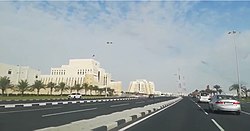Wadi Al Sail
Wadi Al Sail
وادي السيل | |
|---|---|
District | |
 Ministry of Interior in Wadi Al Sail. | |
| Coordinates: 25°18′N 51°30′E / 25.300°N 51.500°E | |
| Country | |
| Municipality | Ad-Dawhah |
| Zone | Zone 12, Zone 20 |
| District no. | 10 |
| Area | |
• Total | 2.2 km2 (0.8 sq mi) |
| Population | |
• Total | 547 |
| • Density | 250/km2 (640/sq mi) |
Wadi Al Sail (Arabic: وادي السيل, romanized: Wādī as Sayl) is a neighborhood of Doha, Qatar.[1][2] The area has undergone much renovation and development in recent years. As its name suggests, the original settlement was built in a wadi. The western partition of the district is known for containing the Qatar Radio and Television Corporation Complex which hosts Al Jazeera's headquarters.[3]
History
[edit]In the 1980s Wadi Al Sail had the least expensive land on average in all of Doha. The land price per ft² in 1981 was $39, and decreased to $11 in 1988, making it the joint-cheapest land on par with Najma.[4]
Landmarks
[edit]
- Al Ahli Hospital on Ahmed bin Ali Street.[5]
- Qatar Media Corporation on Ahmed bin Ali Street.[2]
- Ministry of Interior on Al Thumama Street.[2]
Qatar Radio and Television Corporation Complex
[edit]Located on Khalifa Street,[5] the Qatar Radio and Television Corporation Complex serves as the headquarters of the Al Jazeera Network, among others.[6] On the premises, there is about 70,000 m2 of landscaping, 100 km of asphalt, and paved area of 56,000 m2. Ashghal (The Public Works Authority) launched a QR 138.9 million renovation of the complex in 2010.[3]
Wadi Al Sail Civil Defense Center
[edit]
The Wadi Al Sail Civil Defense Center is located on Ahmed bin Ali Street.[2] The Arab Engineering Bureau was contracted to construct the defense center complex. Completed in 2012, the total developed area is 40,425 m2 and the complex's five structures were built in traditional style. Included among its facilities are a fire station, offices, a drill room, a clubhouse and a mosque. The clubhouse accommodates an auditorium, a swimming pool and classrooms.[7]
Transport
[edit]Major roads that run through the district are Khalifa Street, which is its northern boundary with Lekhwair; Mohammed Bin Thani Street, which is its southern boundary with Rumeila; Al Bidda Street, which is its eastern boundary with Al Dafna; Onaiza Street, which divides the district's western and eastern half; and Ahmed Bin Ali Street, which is its western boundary with Fereej Bin Omran and Fereej Kulaib.[2][8]
Demographics
[edit]As of the 2010 census, the district comprised 88 housing units[9] and 17 establishments.[10] There were 547 people living in the district, of which 31% were male and 69% were female. Out of the 547 inhabitants, 81% were 20 years of age or older and 19% were under the age of 20. The literacy rate stood at 100%.[11]
Employed persons made up 71% of the total population. Females accounted for 72% of the working population, while males accounted for 28% of the working population.[11]
| Year | Population |
|---|---|
| 1986[12] | 3,405 |
| 1997[13] | 3,277 |
| 2004[14] | 2,645 |
| 2010[1] | 547 |
References
[edit]- ^ a b "2010 population census" (PDF). Qatar Statistics Authority. Retrieved 29 June 2015.
- ^ a b c d e "District map". The Centre for Geographic Information Systems of Qatar. Retrieved 16 May 2015.
- ^ a b "Renovation of Qatar Radio and Television Corporation Complex at Wadi al Sail". Ashghal. Retrieved 10 November 2019.
- ^ Fahd Abdul Rahmn Hamad Al-Thani (1992). "The Spatial Impact of the Hydrocarbon Industry on Land and Sea Use in Qatar" (PDF). University of Durham; Durham e-Thesis. p. 325.
- ^ a b "Qatar Landmarks". Ministry of Development Planning and Statistics. Retrieved 7 January 2019.
- ^ Louay Y. Bahry (Summer 2001). "The New Arab Media Phenomenon: Qatar's Al-Jazeera". VIII (2). Middle East Policy Council. Retrieved 10 November 2019.
{{cite journal}}: Cite journal requires|journal=(help) - ^ "New Civil Defence". Arab Engineering Bureau. Retrieved 10 November 2019.
- ^ "Index map of Qatar". ArcGIS.com. Retrieved 25 August 2019.
- ^ "Housing units, by type of unit and zone (April 2010)" (PDF). Qatar Statistics Authority. Retrieved 7 August 2015.
- ^ "Establishments by status of establishment and zone (April 2010)" (PDF). Qatar Statistics Authority. Retrieved 7 August 2015.
- ^ a b "Geo Statistics Application". Ministry of Development Planning and Statistics. Retrieved 7 August 2015.
- ^ "1986 population census" (PDF). Qatar Statistics Authority. Retrieved 7 August 2015.
- ^ "1997 population census" (PDF). Qatar Statistics Authority. Retrieved 7 August 2015.
- ^ "2004 population census". Qatar Statistics Authority. Retrieved 7 August 2015.


